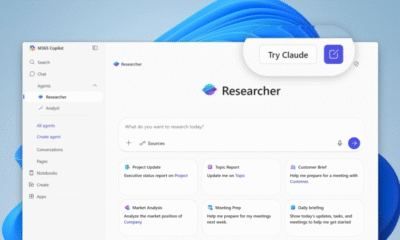Security
Unveiling the Threat: Lessons Learned from 300K Prompt Injection Attacks on AI Security

The Crucial Role of AI Security in Today’s Organizations
The landscape of modern organizations has been forever altered by the advent of artificial intelligence (AI). While the implementation of chatbots and autonomous agents has brought about significant operational changes, there is an underlying security crisis that many technology leaders are only just beginning to grasp. This security threat is not a distant possibility; it is a current reality, with tangible consequences such as the leakage of sensitive source code.
In order to fully comprehend the extent of this challenge, a global research experiment was devised to uncover the vulnerabilities of AI systems in real-world scenarios and explore how security measures can mitigate the risks of potential attacks. The experiment took the form of a $10,000 global prompt injection challenge, where ethical hackers were incentivized to bypass increasingly sophisticated defense mechanisms. The response was overwhelming, with over 800 participants from 85 countries launching more than 300,000 adversarial prompts over the course of 30 days.
The findings of this research, detailed in the report “Defending Against Prompt Injection: Insights from 300K attacks in 30 days,” offer a comprehensive understanding of how these attacks operate and where current defenses fall short.
The Vulnerabilities of Basic AI Defenses
Despite the belief held by some technology leaders that built-in security controls and additional prompt instructions provided by AI vendors offer sufficient protection, real-world testing has proven this assumption to be dangerously flawed.
In the initial stages of the challenge, which relied solely on these basic defensive measures, approximately 1 out of every 10 attacks successfully breached the system. Even more troubling, nearly 1 out of every 5 participants eventually discovered ways to completely circumvent all fundamental protections in these stages.
The root cause of these vulnerabilities lies in the fundamental operations of AI systems. Unlike traditional software that operates based on predictable rules, AI systems generate responses through non-deterministic processes. This means that an attack that fails 99 times against a set of guardrails could succeed on the hundredth attempt due to subtle variations in the system’s internal state.
The Implications of AI Security Failures on Business Operations
As organizations increasingly embrace the integration of agentic AI systems, the potential risks become even more severe. These applications do not function in isolation; they are directly connected to vital business systems through APIs and have access to sensitive databases, email platforms, financial systems, and customer management tools. The autonomy and extensibility of these systems can lead to catastrophic operational failures if not adequately secured.
Joe Sullivan, a former Chief Security Officer at Cloudflare, Uber, and Facebook, highlighted the critical nature of prompt injection in these scenarios. He stated, “Prompt injection is particularly concerning when attackers can manipulate prompts to extract confidential information from an AI model, especially if the model has access to sensitive data through various sources. In autonomous agents connected to APIs, prompt injection can result in unauthorized actions being executed by the AI system, such as sending emails, modifying files, or initiating financial transactions.”
The Tactics of Advanced Attackers Utilizing Cognitive Manipulation
An insightful revelation from the analysis of sophisticated attackers lies in their strategic approach. Joey Melo, a professional ethical hacker who successfully completed the final level of the challenge, devised a multi-layered attack strategy over two days of continuous testing. He described it as the most challenging prompt injection challenge he had encountered.
Instead of relying on overt manipulation tactics, Melo’s solution incorporated cognitive hacking techniques that exploit the ways in which AI systems process and assess information. His attack involved the use of distractor instructions to conceal malicious intent, cognitive manipulation to guide the AI system towards validating his prompts, and style injection methods to present sensitive data in formats that evade traditional content filters.
Melo also brought attention to a lesser-known threat posed by AI systems, which is the inadvertent revelation of actionable intelligence about an organization’s internal infrastructure. He explained, “An AI chatbot may inadvertently disclose details about the underlying infrastructure it operates on, such as software versions, server information, internal IPs, and accessible open ports.”
Effective AI Security: The Power of Layered Defense
The research findings clearly demonstrate the difference between effective AI security measures and wishful thinking. The success rates of attacks across various defensive approaches underscore the importance of layered protection.
While basic prompt defenses proved to be insufficient, with an average success rate of 7 percent, environments that integrated content inspection guardrails to actively monitor and filter inputs and outputs saw a significant decrease in attack success rates to just 0.2 percent. The implementation of prompt injection detection systems utilizing statistical methods and LLM-driven analysis further reduced success rates to an almost negligible 0.003 percent.
This progression illustrates not only the effectiveness of individual defense mechanisms but also the cumulative protection offered by layered AI defenses. Each additional layer not only enhances protection but fundamentally alters the attack landscape by necessitating adversaries to overcome multiple distinct defensive systems simultaneously.
Establishing Comprehensive AI Defenses: An Immediate Imperative
According to McKinsey research, 78 percent of organizations now leverage AI in at least one business function, yet a significantly smaller percentage have established dedicated AI security capabilities. This discrepancy poses a critical vulnerability that grows more precarious as AI systems become deeply ingrained in business operations.
The research uncovered a spectrum of attack methods, ranging from simplistic single-word prompts to intricate multi-layered strategies involving cognitive manipulation and obfuscation techniques. While the effectiveness of these methods varied, a consistent finding was the inadequacy of basic defenses against determined attackers.
Organizations that grasp the urgency of this challenge and invest in comprehensive AI security measures today stand to gain substantial competitive advantages. By addressing the foundational security risks associated with AI systems, they can confidently deploy GenAI systems without fear of data breaches, operational disruptions, or reputational harm.
The choice before organizations is clear-cut: either invest in comprehensive AI security measures now, while the technology and defense strategies are still evolving, or risk becoming cautionary tales in future security incident reports. The evidence gleaned from nearly 300,000 real-world attack attempts underscores the urgency of this decision. The AI revolution does not necessitate a slowdown; rather, it demands a bolstering of security measures, a transformation that must commence without delay.
Pangea has developed a practical classification of prompt attack methods based on this research, detailing numerous types of attacks. Explore Pangea’s Taxonomy of Prompt Injection Methods for further insights.
 Oliver Friedrichs serves as the Founder and CEO of Pangea, where he spearheads AI security initiatives through intelligent guardrails. With a track record of building and selling four cybersecurity companies to industry giants like Splunk, Cisco, Symantec, and McAfee, Oliver brings a wealth of expertise to the field.
Oliver Friedrichs serves as the Founder and CEO of Pangea, where he spearheads AI security initiatives through intelligent guardrails. With a track record of building and selling four cybersecurity companies to industry giants like Splunk, Cisco, Symantec, and McAfee, Oliver brings a wealth of expertise to the field.
Connect with Oliver on LinkedIn or visit https://pangea.cloud/ for more information.
-

 Facebook3 days ago
Facebook3 days agoWarning: Facebook Creators Face Monetization Loss for Stealing and Reposting Videos
-

 Facebook4 days ago
Facebook4 days agoInstaDub: Meta’s AI Translation Tool for Instagram Videos
-

 Video Games4 days ago
Video Games4 days agoGoku Takes on the Dragon Ball FighterZ Arena
-

 Facebook3 days ago
Facebook3 days agoFacebook Compliance: ICE-tracking Page Removed After US Government Intervention
-

 Video Games5 days ago
Video Games5 days agoTekken 8: Rise of the Shadows
-

 Microsoft3 days ago
Microsoft3 days agoMicrosoft Integrates Anthropic’s Claude AI Models into 365 Copilot: A Deepening Relationship with OpenAI
-

 Cars3 days ago
Cars3 days agoRevving into the Future: Ferrari’s Plan to Unleash 20 New Models, Including Electric Vehicles, by 2030
-

 Amazon5 days ago
Amazon5 days agoNeil Young Takes a Stand: Pulling Music from Amazon in Protest of Jeff Bezos’ Support for Trump






























